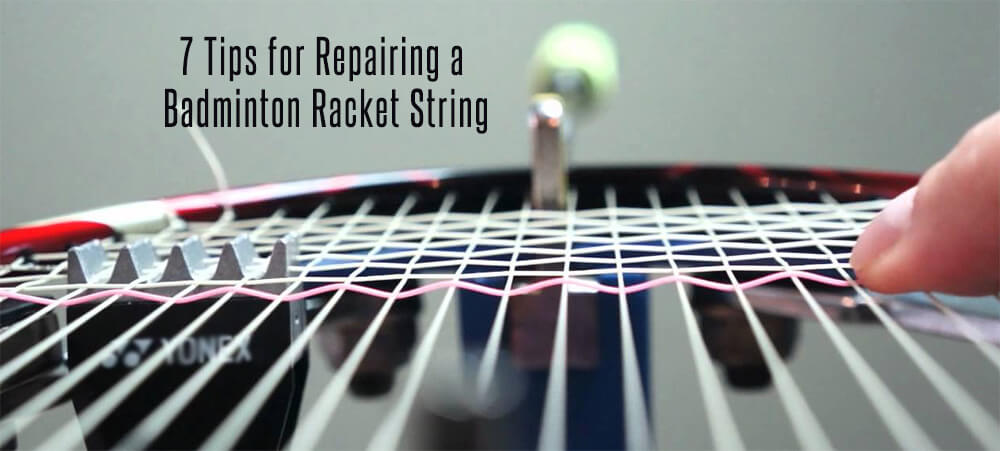
7 Tips for Repairing a Badminton Racket String
If you love playing badminton, then you've probably encountered a broken string or two in your time. But there's no need to replace your badminton racket just yet. Click here for some tips to help you repair a badminton racket string so that you can get on your way to playing again.
Every badminton enthusiast has had a similar experience. You're playing your heart out, you hit a great shot, and suddenly you hear that dreaded "ping." You've broken a string.
While they might put a stop to your game, broken badminton strings aren't the end of your racket. In fact, they don't even have to be an expensive problem. Whether you need to fix or restring your racket, doing it yourself can be an inexpensive fix.
The next time you break a badminton racket string, this guide will help you get your racket back in tip-top shape.
How to Repair a Broken Badminton Racket String
Let's say your racket only has one or two broken strings. In this case, you don't need to restring the entire racket. You can fix only the strings that are broken. Here's how:
1. Secure the Other Strings
There are a few ways your strings may have been attached to your racket. In some cases, a racket has two long pieces of string: one for the vertical mains and one for the horizontal strings. Otherwise, your racket may have many individual strings: one for each main and one for each horizontal.
If each string is separate, you can just remove the broken string and the other strings will stay in place. If you only have two long strings, use a knot to secure the last string possible at the grommet. Make sure you maintain the right tension and use a specialized clamp while you tie the knot. Cut off the remainder of the broken string.
2. Cut a Length of New String
Different types of string behave in different ways. Make sure you use the same string for the repair that the rest of the racket contains. Cut a length that is long enough to fix the defect with a couple of feet to spare.
3. Attach the Fresh String
Put one end of the new string into the grommet below the defect. Tie a knot to secure it.
4. Replace the Broken String
When the fresh string is secured, bring it up through the grommet that has a missing string. Weave the new string through the strings that go the other way.
Make sure you're weaving opposite of the string next to yours. For instance, let's assume you're replacing a horizontal string. Every time the horizontal below yours goes under a main, your string should go on top of that main, and vice versa.
5. Give the New String Tension
When you get to the other end of the racket, pull the string through the grommet. Wrap the end of the string around a hammer handle or another type of instrument that has some grip. Use that tool to tighten the string until it has the same tension as the strings next to it.
When you reach your desired tension, use a clamp to secure it in place.
6. Finish the String
Finally, pull the end of the string through the next grommet above the defect. Tie a simple knot to secure it. Cut off the excess string from both sides of the new string and you're ready to play.
Tips for Restringing a Badminton Racket
If your racket has too many broken strings, your best bet may be to restring the racket entirely. In this case, it's best to either use a stringing machine or take the racket to a professional. Regardless of which option you choose, here are some tips:
1. Inspect Your Racket
While you should inspect your racket on a regular basis, it's always important to do it before you restring. Look for cracks or collapsed areas in the frame. If you have these defects, your badminton racket could break when you put it under tension to restring it.
If your racket breaks during the stringing process, it could cause an injury. Any defects in the frame mean it's time for a new racket.
You should also look for damaged or missing grommets during this process. Damaged grommets will place extra tension on your racket, causing it to break faster. It's easy and convenient to replace any broken or missing grommets during the re-stringing process.
Keep in mind that if a professional re-strings your racket, they should look for defects. Still, it's important to do the same on your own. You don't want them to try to talk you into paying for a repair or replacement you don't need.
2. Specify the String You Prefer
There are countless brands and types of string available. If you know your favorite type of badminton racket string, buy it to use or tell a professional that this is what you want. Some shops will let you bring them the string you want and others will use their own.
If you don't tell a stringer what type of string to use, they may use the cheapest kind they have. In this case, you may find yourself returning for a re-stringing often.
3. Tailor Your Tension to Your Skill Level
Whether you're re-stringing the racket yourself or you're taking it to a professional, find out what level of tension you want. The string's tension will affect how much power and control you get during a game. It will also affect how long the string lasts.
If you're a beginner, start with anything between 17 pounds and 20 pounds of tension. As your skin advances to the intermediate level, you can increase the tension to 22 or 25 pounds. Gradually increase it as your skills improve.
Professional badminton players use a tension of 30 pounds or more. Victor Axelsen using a 32-33lbs as a string tension. However, be careful not to overestimate the tension you need. Too much tension will send more of the impact to your wrist every time you hit the shuttlecock. This can lead to an injury. Concentrate on your game and not to satisfy your ego by choosing the higher tension because your friend is playing.
Keep in mind that different rackets can also handle different levels of tension. Before you increase your tension, make sure your racket is rated for it.
If you're re-stringing the racket yourself your racket stringing machine should be able to let you set the tension. If you're taking it to a professional, let them know the tension you want.
Keeping Your Badminton Racket Play-Ready
Like any other type of sporting equipment, badminton rackets need proper maintenance. Keeping an eye out for defects and fixing them promptly can help you enjoy your racket for years to come.
To shop for badminton racket string and other equipment, check out our online sports shop.
Your email address cannot be published. Required fields are marked*

 My Account
My Account Track Order
Track Order Sports Guide
Sports Guide

No comments